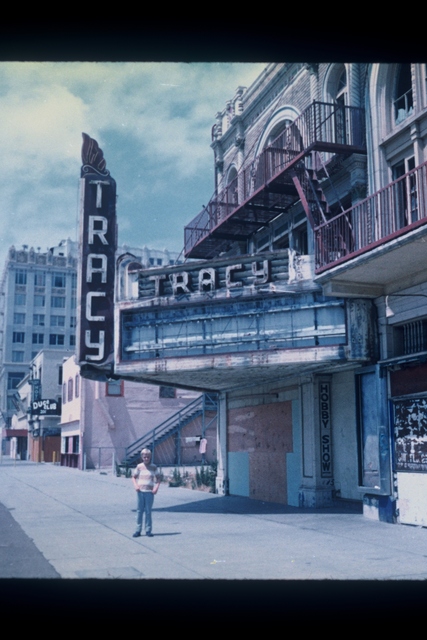
Tracy Theatre
219 E. Seaside Way,
Long Beach,
CA
90802
![]() 4 people
favorited this theater
4 people
favorited this theater
Additional Info
Previously operated by: Far West Theatres Inc.
Architects: H. Alfred Anderson, Carl Boller
Firms: Boller Brothers
Styles: Art Deco
Previous Names: Ritz Theatre, Capitol Theatre
Nearby Theaters
Opened as the Ritz Theatre on May 24, 1925 with Bebe Daniels in “The Crowded Hour” plus on the stage a musical revue “The 1925 Edition of Medal Winners” and 4-acts of vaudeville. It was equipped with a Robert Morton theatre pipe organ. The name was soon changed to Capitol Theatre on November 4, 1925 when it was operated by the L. Lou Bard chain Far West Theatres Inc. It was badly damaged by an earthquake on March 10, 1933 and it was remodeled to the plans of architect H. Alfred Anderson.
By 1938 it had been renamed Tracy Theatre. It was still open in 1956, but had closed by 1957. It was demolished in late-March 1974.
Just login to your account and subscribe to this theater.

Recent comments (view all 57 comments)
Very excited to find the great information on the Tracy Theater. As a young girl I attend the theater many times with my close friend Catherine Tracy whose father owned the Theater.
Catherine and I were school mates and best friends during the late 1930’s. I lost touch with the family and would be very happy to hear from anyone in the Tracy family. Catherine’s married name was Cobb.
If you have information about her or her family members please contact me at Thank You. Alice K
Great pictures too bad its is gone now!
Here is a 1932 photo from the Long Beach Library:
http://tinyurl.com/2bqhpn8
Very good vintage photo ken mc.
The Long Beach Library photo two posts above can’t be from 1932. Someone must have mislabeled it. The swing-out sign mounted on the theatre’s facade would have been of that vintage, or a little earlier, but the marquee is of 40s vintage. Trapezoidal and wedge-shaped marquees did not appear until 1935-‘36. The marquee shown in the photo was still on the theatre in 1973, when my adopted grandmother Mary Tolson snapped a picture (which I still have) of me standing under it. At the time, I was fascinated by the Tracy—though I never went inside. It’s boarded-up entrance and broken second story windows and terra cotta masks had me hooked the way many children get spooked and fascinated by old abandoned mansions. I remember even at that age noticing that the neon “crest” on the vetical sign was similar (though simpler) to that on the Belmont Theatre in Belmont Shores, which was still very much in operation at that time, and which we occasionally attended.
The photo is probably from 1939. The movie “Missing Daughters” was released that year. The “Jack London Hit” on the marquee could have been “Mutiny on the Elsinore” which was made in 1937 but not released in the U.S. until February, 1939, according to IMDb. Another London tale called “Torture Ship” hit the screen in October, 1939. The marquee looks brand new in that photo.
I don’t know who Norvell was, though, and the Internet isn’t helping, but the name rings a vague bell. Was he a mentalist? An illusionist? Probably something of that sort if he was doing a stage act that was not part of a larger vaudeville show.
The “New Theatre Projects” column of Motion Picture Herald, July 1, 1933, had this item about the Capitol Theatre:
As the Tracy’s front clearly dated from well before 1933, the rebuilding must have been confined primarily to the interior and rear of the house. The Capitol was one of four Long Beach theater repair or rebuilding projects listed in the column that week, all of which must have been occasioned by the large earthquake that had struck the city on March 10.It’s interesting to note that architect H. Alfred Anderson’s address, 30 Pine Avenue, was in the Palace Theatre building, which he had designed in 1916.
Opened as Ritz on May 24th, 1925
Became the Capitol theatre on November 4th, 1925. Grand opening ad posted.
Eugene V. Tracy renamed the theatre as the Tracy. Likely ended theatrical and live stage presentations in 1950 at the end of a 25-year lease. It was a non-profit center for church services and Youth for Christ from 1952 until 1957 and then was offered for sale fore $65,000 in 1959.